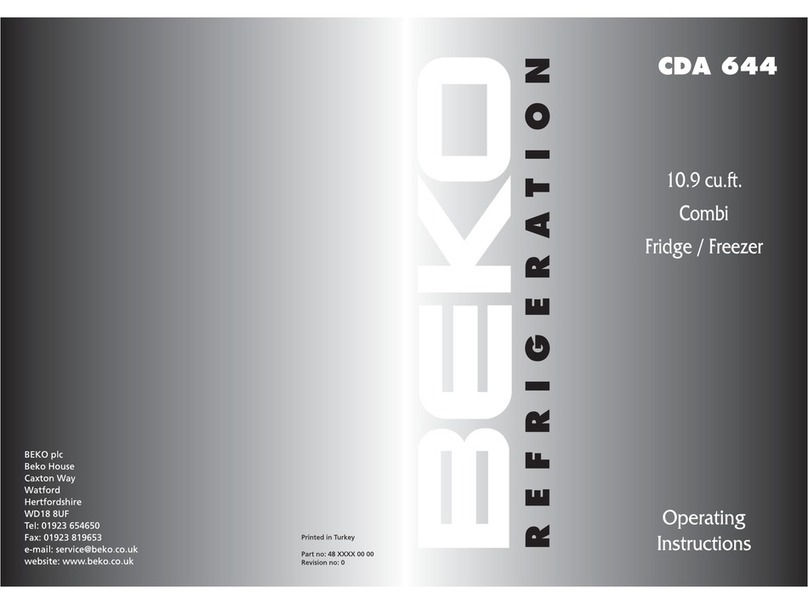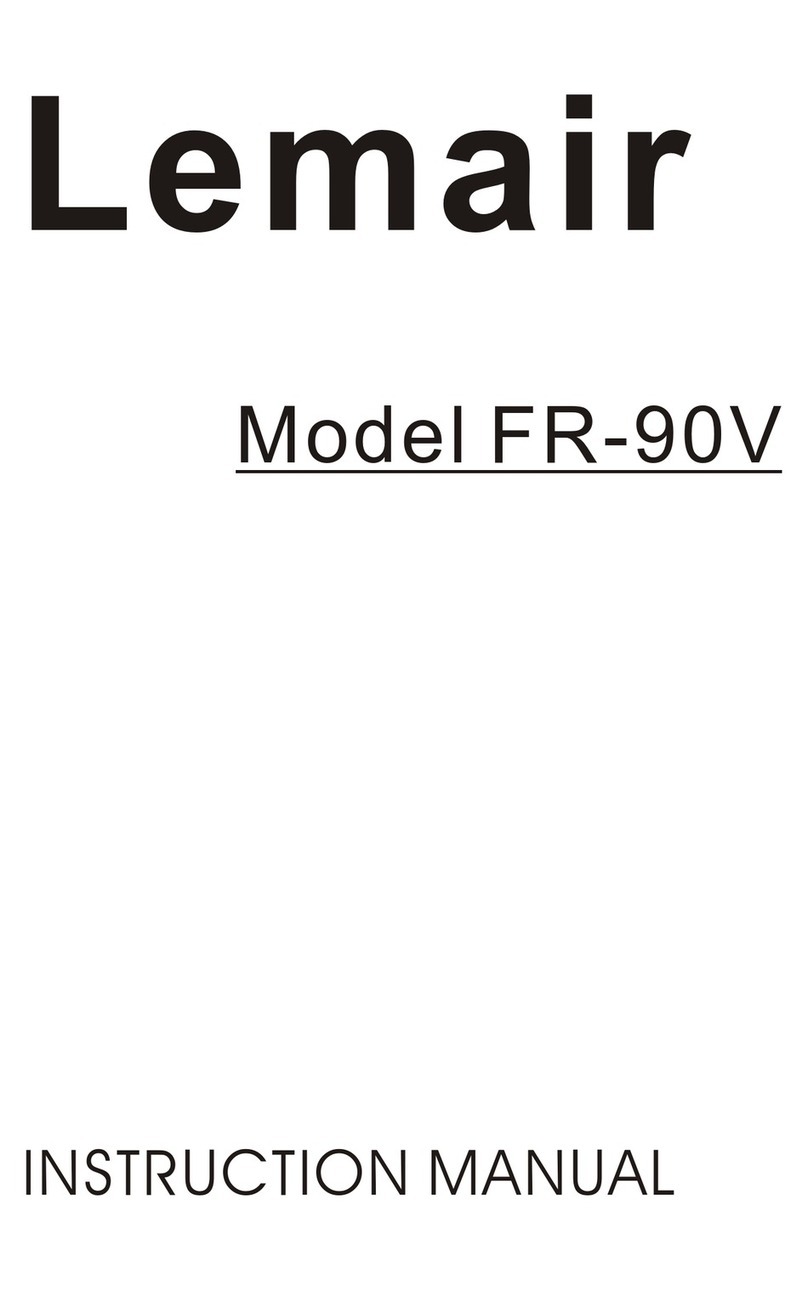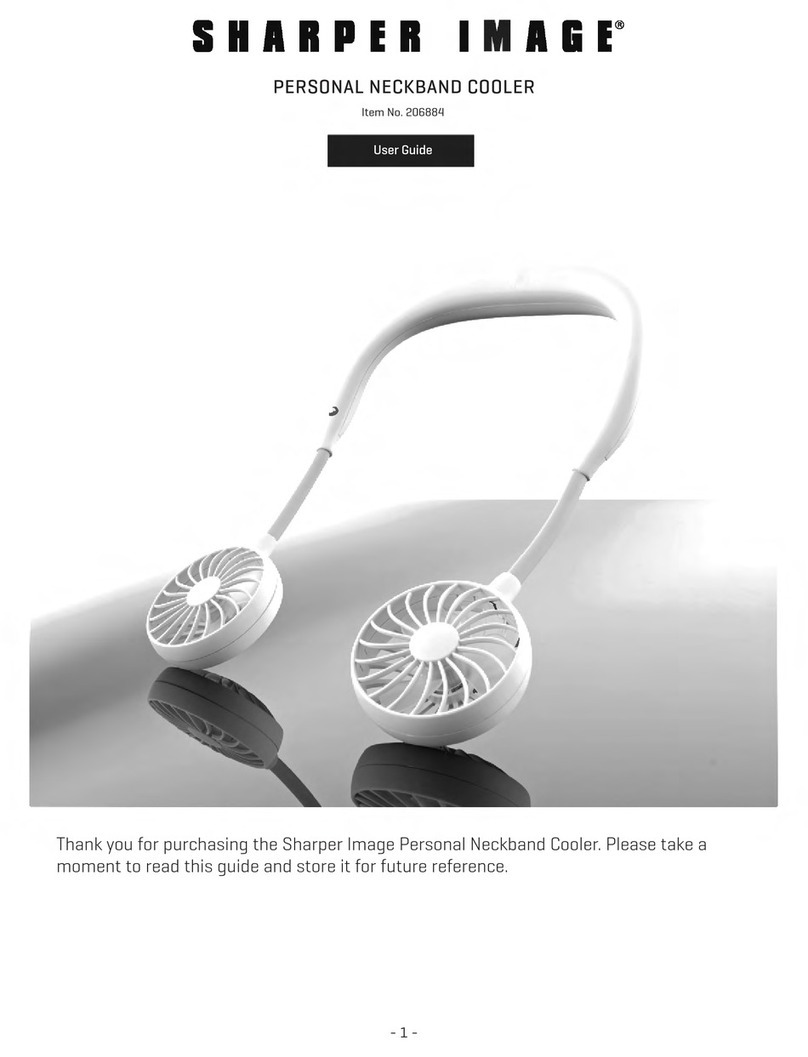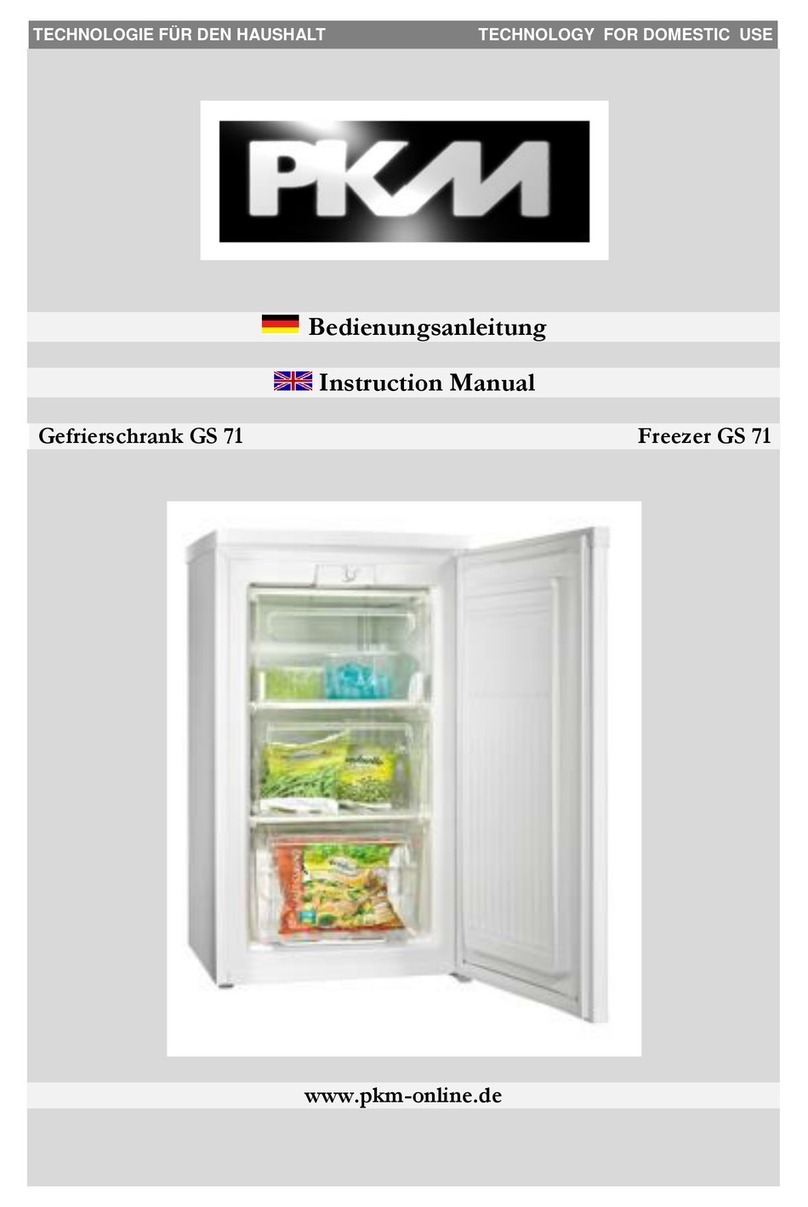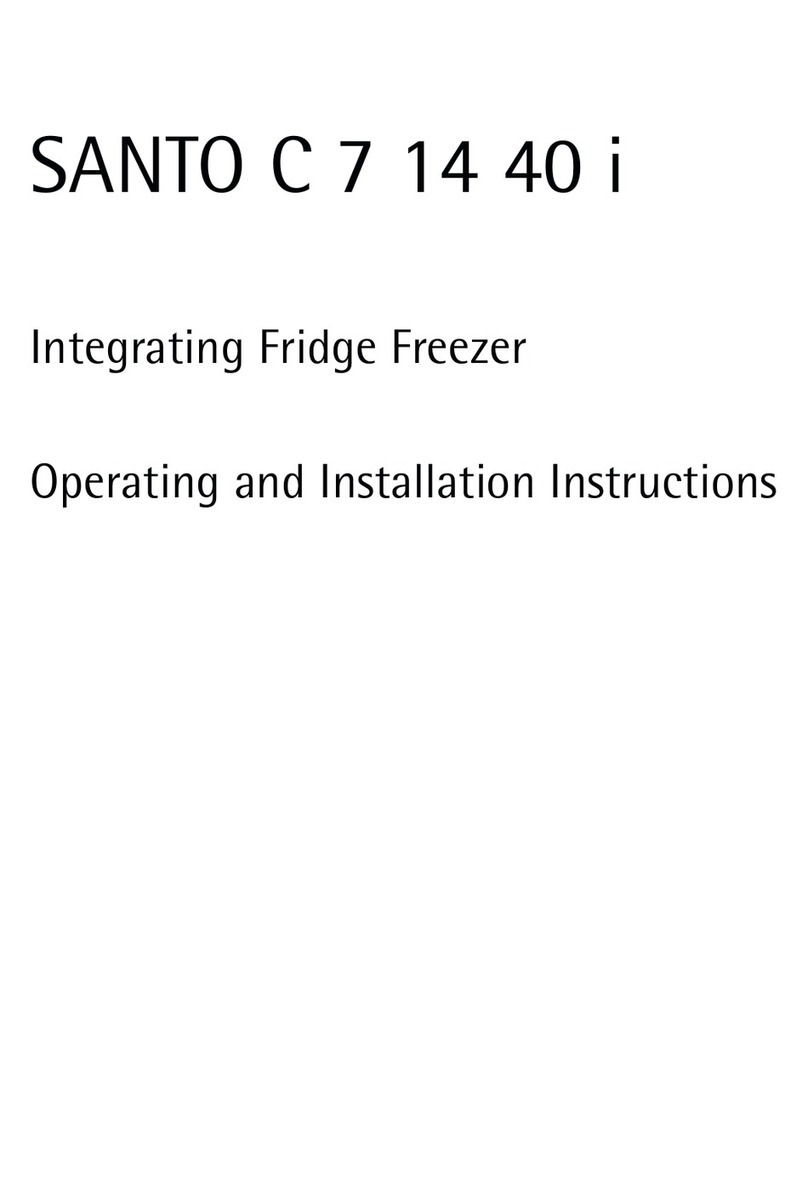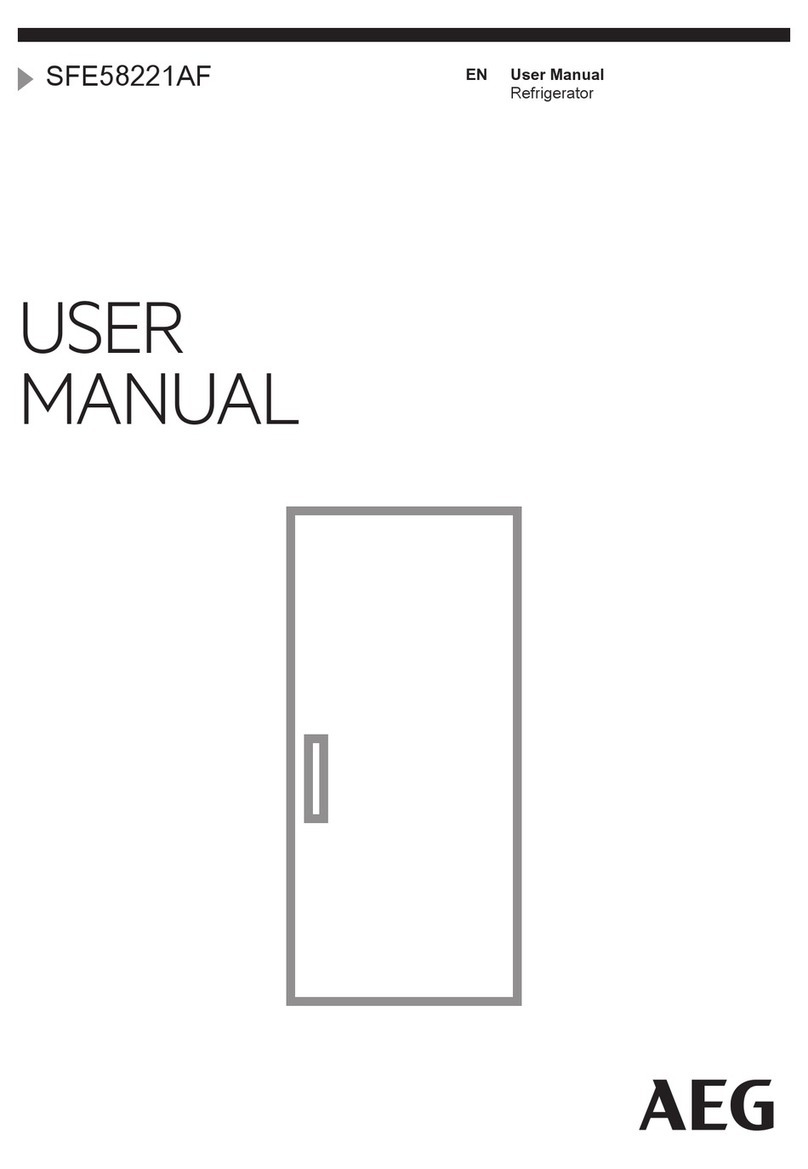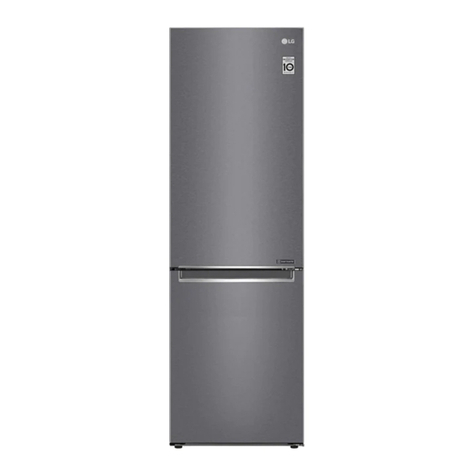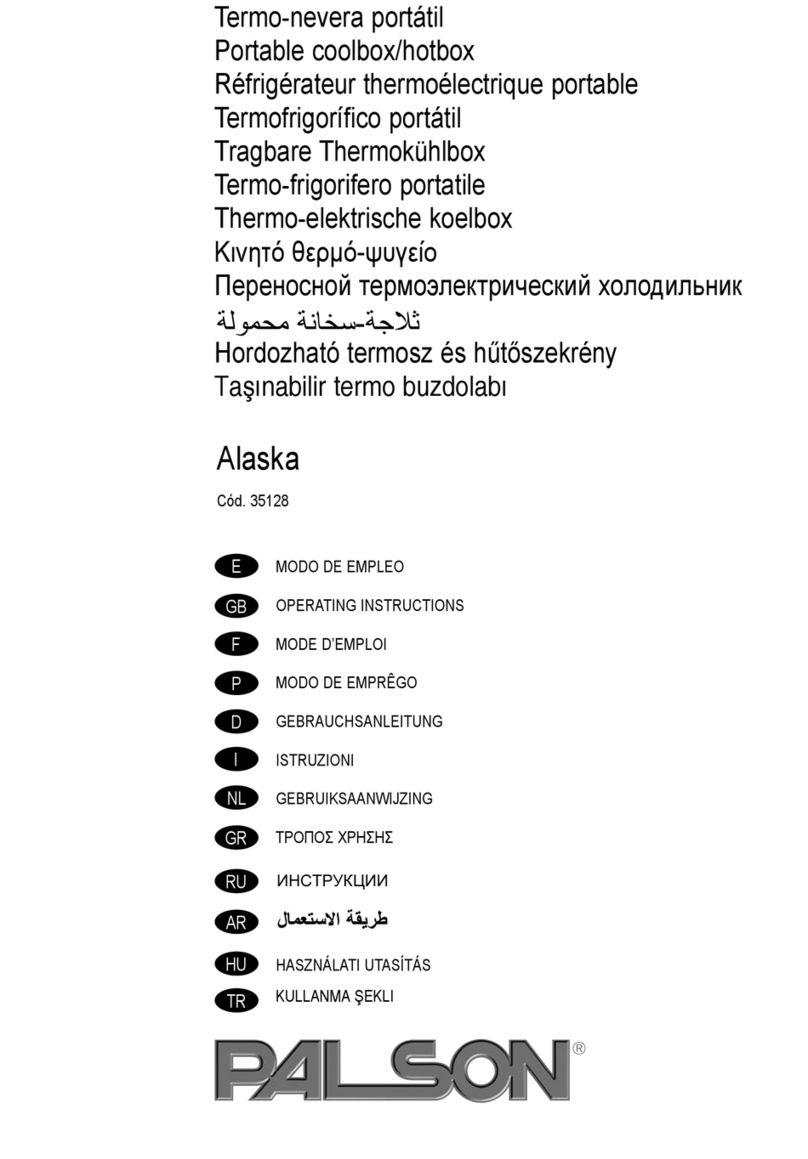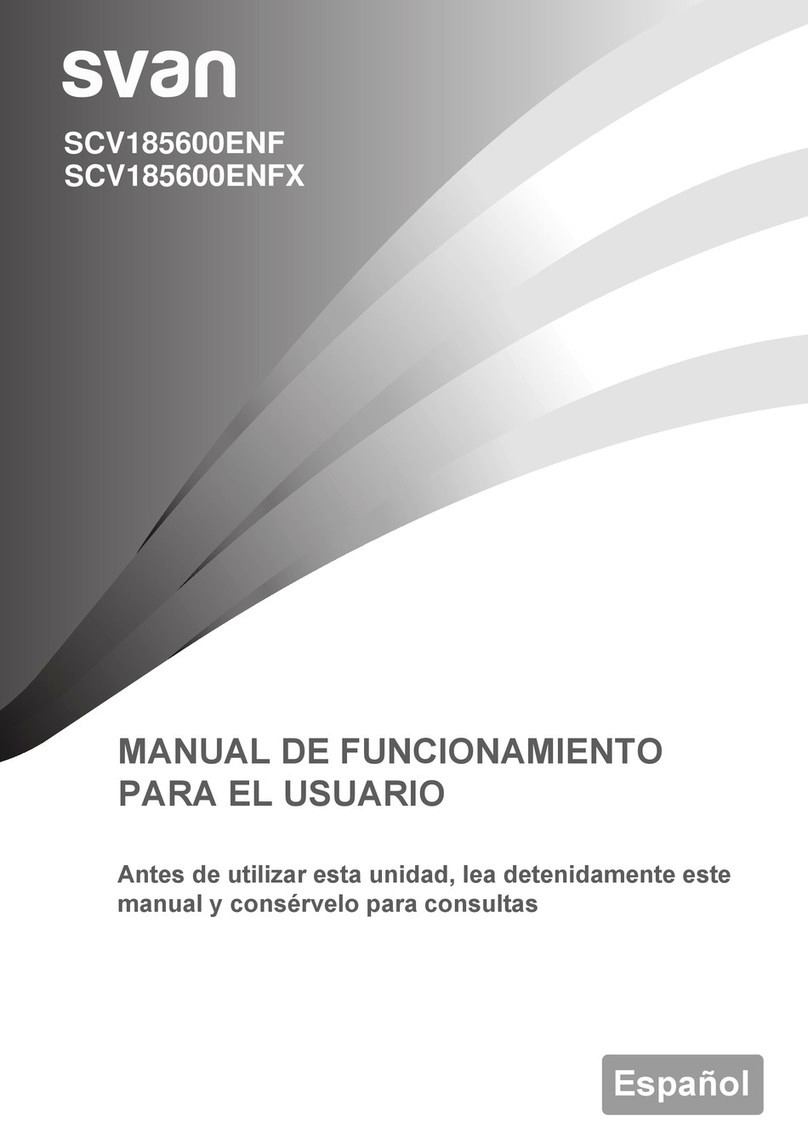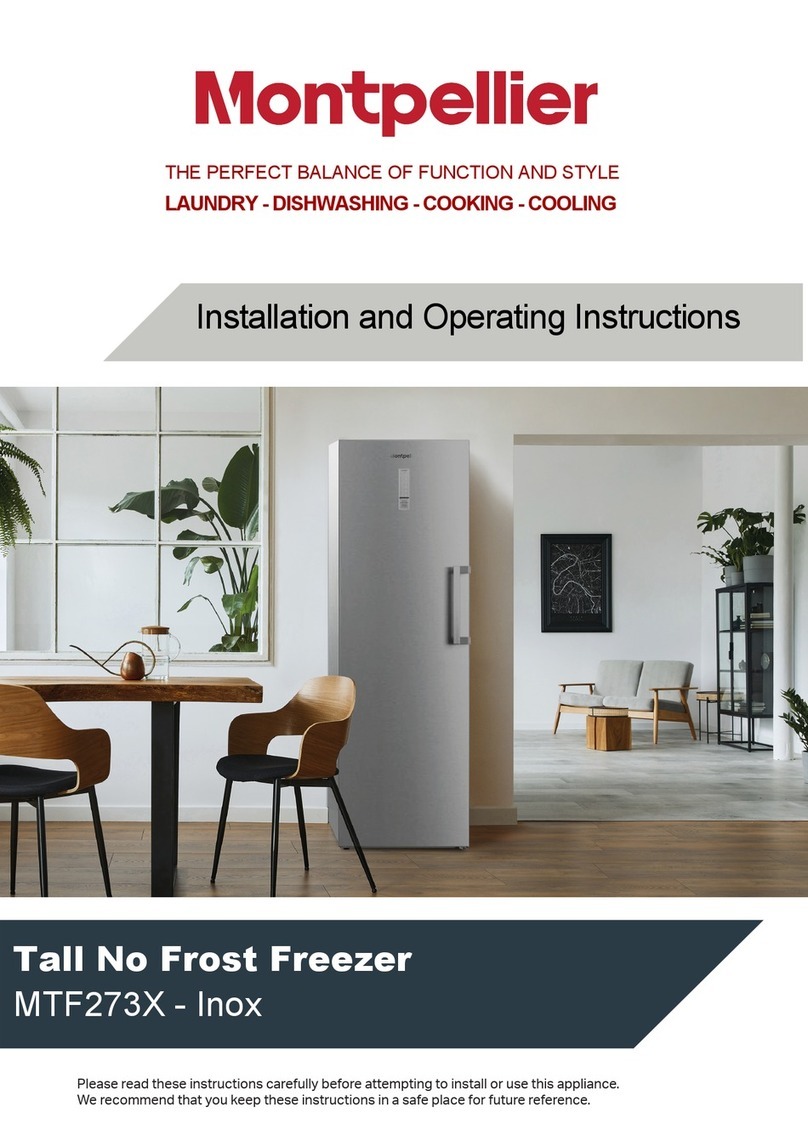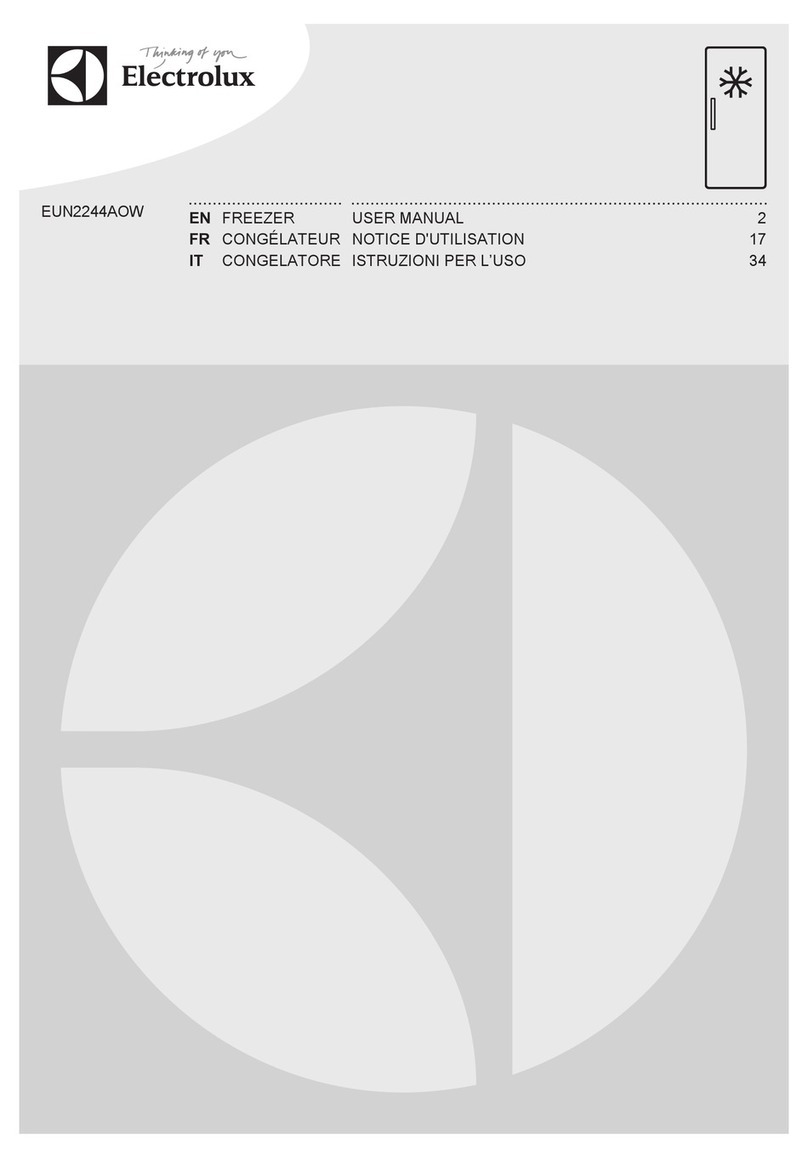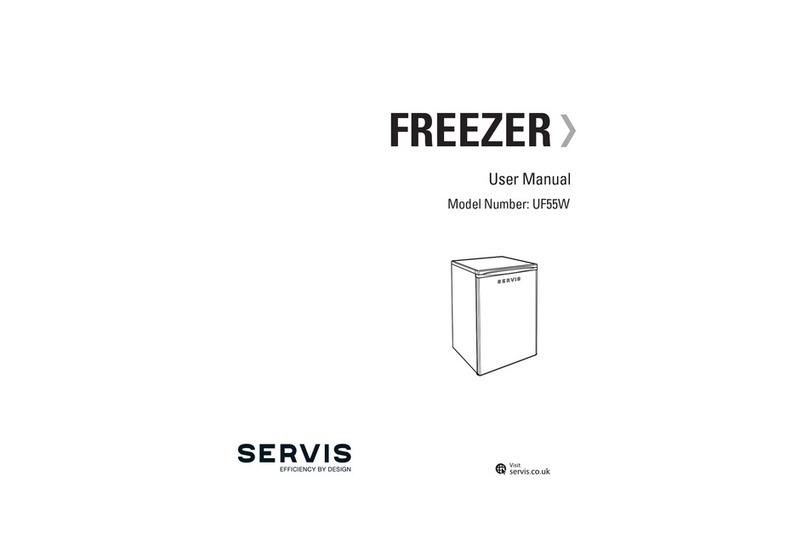Thermo Forma 8523 Operating instructions

Model:
8523/8584
Ultra Low Temperature
Upright Freezer
23 cu. ft. capacity
Operating and Maintenance Manual
Manual No: 7008523 Rev. 10

Model 8523/8584__________________________________________________________________
i
The material in this manual is for information pur-
poses only. The contents and the product it describes are sub-
ject to change without notice. Thermo Forma makes no rep-
resentations or warranties with respect to this manual. In no
event shall Thermo Forma be held liable for any damages,
direct or incidental, arising out of or related to the use of this
manual.
IMPORTANT!
Read This Instruction Manual
Failure to read, understand and follow the instruc-
tions in this manual may result in damage to the unit, injury
to operating personnel and poor equipment performance.
CAUTION! All internal adjustments and mainte-
nance must be performed by qualified service per-
sonnel.
MANUAL NO. 7008523
10 20935/FR-1630 7/9/02 Corrected Low Battery Alarm Illumination aks
9 20762/FR-1606 5/20/02 Added ‘Normally Open’ to description of expansion tank solenoid valve ccs
20845/FR-1616 5/21/02 Updated refrigerant charge on schematics (oil return issue) ccs
-- 20684/FR-1596 4/2/02 Added sample pull-down curve after specs ccs
8 20644/FR-1557 3/11/02 Added two expansion tanks to refrig system ccs
7 20251/FR-1526 2/21/02 Cordset connector aks
6 20522/FR-1557 12/7/01 Updated electrical schematics to 12 FLA ccs
5 20400/FR-1557 11/16/01 Added expansion tank with solenoid and relay timer (Release 11) ccs
4 19798/FR-1481 1/15/01 Updated elec. schematics (1A 230110 to 2A 230111) aks
3 19404/FR-1441 9/21/00 New temperature control board ccs
2 19154/FR-1421 9/1/00 Updated parts and refrigeration drawings (dryer part number) ccs
1 19151/FR-1384 7/20/00 Resize Cabinet (RICH) aks
0 -- 4/20/00 New Manual aks
REV ECR/ECN DATE DESCRIPTION By

ii
Model 8523/8584_______________________________________________________________________________Service

Model 8523/8584________________________________________________________________________________Safety
iii
Important operating and/or maintenance instructions. Read the accompanying text carefully.
Ce symbole attire l'attention de l'utilisateur sur des instructions importantes de fonctionnement et/ou d'entretien. Il
peut être utilisé seul ou avec d'autres symboles de sécurité. Lire attentivement le texte d'accompagnement.
Wichtige Betriebs- und/oder Wartungshinweise. Lesen Sie den nachfolgenden Text sorgfältig.
Importante instruccions de operacion y/o mantenimiento. Lea el texto acompanante cuidadosamente.
Potential electrical hazards. Only qualified persons should perform procedures associated with this symbol.
Ce symbole attire l'attention de l'utilisateur sur des risques électriques potentiels. Seules des personnes qualifiées
doivent appliquer les instructions et les procédures associées à ce symbole.
Gefahr von Stromschlägen. Nur qualifizierte Personen sollten die Tätigkeiten ausführen, die mit diesem Symbol
bezeichnet sind.
Potencial de riesgos electricos. Solo personas das capacitadadas deben ejecutar los procedimientos asociadas con
este simbulo.
Equipment being maintained or serviced must be turned off and locked off to prevent possible injury.
Risques potentiels liés à l'énergie. L'équipement en entretien ou en maintenance doit être éteint et mis sous clé pour
éviter des blessures possibles.
Geräte, an denen Wartungs- oder Servicearbeiten durchgeführt werden, müssen abgeschaltet und abgeschlossen wer-
den, um Verletzungen zu vermeiden.
El equipo recibiendo servicio o mantenimiento debe ser apagado y segurado para prevenir danos.
Hot surface(s) present which may cause burns to unprotected skin or to materials which may be damaged by elevat-
ed temperatures
Présence de surface(s) chaude(s) pouvant causer des brûlures sur la peau non protégée, ou sur des matières pouvant
être endommagées par des températures élevées.
Heiße Oberfläche(n) können ungeschützter Haut Verbrennungen zufügen oder Schäden an Materialien verursachen,
die nicht hitzebeständig sind.
Superficias calientes que pueden causar quemaduras a piel sin proteccion o a materiales que pueden estar danados
por elevadas temperaturas.
;Always use the proper protective equipment (clothing, gloves, goggles etc.).
;Always dissipate extreme cold or heat and wear protective clothing.
;Always follow good hygiene practices.
;Each individual is responsible for his or her own safety.
General Safety Notes used in this Manual

Model 8523/8584______________________________________________________________________Table of Contents
iv
Table of Contents
Section 1 - Installation and Start-Up
1.1 Unloading and Moving the Freezer . . . . . . . . . . . . . . . . .1-1
1.2 Getting to Know Your Freezer . . . . . . . . . . . . . . . . . . . . .1-1
1.3 Environmental Conditions . . . . . . . . . . . . . . . . . . . . . . . .1-3
1.4 Installing the Wall Bumpers . . . . . . . . . . . . . . . . . . . . . . .1-3
1.5 Installing the Shelves . . . . . . . . . . . . . . . . . . . . . . . . . . .1-3
1.6 Location . . . . . . . . . . . . . . . . . . . . . . . . . . . . . . . . . . . . . .1-3
1.7 Alarm Contacts, RS-232 Interface and Millivolt Output 1-3
1.8 Optional Temperature Recorder . . . . . . . . . . . . . . . . . . .1-3
1.9 Water-cooled Condenser . . . . . . . . . . . . . . . . . . . . . . . . .1-4
1.10 Attaching the Power Cord . . . . . . . . . . . . . . . . . . . . . . .1-4
1.11 Power Switch (mains disconnect) . . . . . . . . . . . . . . . . .1-4
1.12 Electrical Requirement and Connection . . . . . . . . . . . . .1-4
1.13 Factory Settings . . . . . . . . . . . . . . . . . . . . . . . . . . . . . . .1-4
1.14 Start Up and Loading . . . . . . . . . . . . . . . . . . . . . . . . . . .1-4
Section 2 - Operation . . . . . . . . . . . . . . . . . . . . . . . . . . . . . .2-1
2.1 Changing the Control Temperature Set Point . . . . . . . . .2-1
2.2 Changing the High Temperature Alarm Set Point . . . . . .2-1
2.3 Changing the Low Temperature Alarm Set Point . . . . . .2-1
2.4 Changing the Access Code . . . . . . . . . . . . . . . . . . . . . . . .2-1
2.6 Silencing the Alarms: . . . . . . . . . . . . . . . . . . . . . . . . . . .2-2
2.7 Function Buttons . . . . . . . . . . . . . . . . . . . . . . . . . . . . . . .2-2
2.5 Alarms . . . . . . . . . . . . . . . . . . . . . . . . . . . . . . . . . . . . . . .2-2
2.8 The RS-232 Configuration . . . . . . . . . . . . . . . . . . . . . . .3-1
Section 3 - Calibration . . . . . . . . . . . . . . . . . . . . . . . . . . . . .3-1
3.1 Display (Alarm) Probe Calibration . . . . . . . . . . . . . . . .3-1
3.2 Control Temperature Set Point Probe Calibration . . . . . .3-1
3.3 Recorder Calibration . . . . . . . . . . . . . . . . . . . . . . . . . . . .3-2
a. Changing the recorder range: . . . . . . . . . . . . . . . . . . .3-2
b. Calibrating the chart recorder: . . . . . . . . . . . . . . . . . .3-2
Section 4 - Routine Maintenance . . . . . . . . . . . . . . . . . . . .4-1
4.1 Cleaning the Cabinet Exterior . . . . . . . . . . . . . . . . . . . . .4-1
4.2 Cleaning the Air Filter . . . . . . . . . . . . . . . . . . . . . . . . . . .4-1
4.3 Cleaning the Condenser . . . . . . . . . . . . . . . . . . . . . . . . . .4-1
a. Cleaning the Water-cooled Condenser . . . . . . . . . . . .4-1
4.4 Defrosting the Chamber . . . . . . . . . . . . . . . . . . . . . . . . .4-1
4.5 Cleaning the Door Gasket . . . . . . . . . . . . . . . . . . . . . . . .4-1
4.6 Cleaning the Vacuum Relief Port . . . . . . . . . . . . . . . . . . .4-1
4.7 Replacing the Battery . . . . . . . . . . . . . . . . . . . . . . . . . . .5-1
4.8 Deactivating the EnviroScan . . . . . . . . . . . . . . . . . . . . . .5-1
4.9 Preparing the Unit for Storage . . . . . . . . . . . . . . . . . . . .5-1
Section 5 - Service . . . . . . . . . . . . . . . . . . . . . . . . . . . . . . . . .5-1
5.1 Servicing the Refrigeration System . . . . . . . . . . . . . . . . .5-1
5.2 Troubleshooting Chart . . . . . . . . . . . . . . . . . . . . . . . . . . .5-2
Section 6 - Specifications . . . . . . . . . . . . . . . . . . . . . . . . . . .6-1
Section 7 - Parts List . . . . . . . . . . . . . . . . . . . . . . . . . . . . . . .7-1
Section 8 - Refrigeration Schematics . . . . . . . . . . . . . . . . . .8-1
Section 9 - Electrical Schematics . . . . . . . . . . . . . . . . . . . . .9-1
Section 10 - Warranty . . . . . . . . . . . . . . . . . . . . . . . . . . . . . .10-1

Model 8523/8584____________________________________________________________________________Installation
1-1
Section 1 - Installation and Start-Up
1.1 Unloading and Moving the Freezer
To remove the freezer from the pallet, use the 7/16"
wrench to remove all the bolts securing the shipping bracket to
the pallet.
Remove the shipping bracket. Remove the ramp boards
from the pallet and place the slotted end over the ramp brackets
on the pallet. The support blocks on the ramps will be facing
down. Before moving the freezer, make sure the casters are
unlocked and moving freely. Align the caster with the ramp
boards. Use adequate personnel to roll the freezer off the pallet.
The freezer can be easily pushed to the desired
approved location, described in Section 1.6. If necessary, the
doorstop may be removed to allow the door to swing fully open
to move the unit through tight openings. When the freezer is in
position, set the front caster brakes.
If tipped more than 45°, allow the unit to set
upright for 24 hours before start up.
The freezer must not be moved with the prod-
uct load inside.
Non-CFC
1.2 Getting to Know Your Freezer
Figure 1-1, EnvironScan™ Monitor
Figure 1-2
Freezer Exterior, front view
Figure 1-3
Freezer Base, rear view

Model 8523/8584__________________________________________________________________________Installation
1-2
Figure 1-4, Vacuum Relief Port
and Chamber Probe
Figure 1-5
Freezer Base Front
Figure 1-6, Vacuum Relief Port and Chamber
Probe Assembly (without cover)

Model 8523/8584____________________________________________________________________________Installation
1-3
1.3 Environmental Conditions
The ULT Freezers are designed to be electrically safe in the fol-
lowing environmental conditions:
• Indoors
• Altitude: Up to 2,000 meters
• Temperature: 5°C to 43°C
• Humidity: 80% RH at or below 31°C, decreasing linearly to
50% RH at 40°C
• Mains Supply Fluctuations: ± 10% of nominal.
• Installation Category II 1
• Pollution Degree 2 2
• Class of Equipment I
• Climatic Class T (Tropical)3
1Installation category (overvoltage category) defines the level
of transient overvoltage which the instrument is designed to
withstand safely. It depends on the nature of the electricity sup-
ply and its overvoltage protection means. For example, in CAT
II which is the category used for instruments in installations sup-
plied from a supply comparable to public mains such as hospital
and research laboratories and most industrial laboratories, the
expected transient overvoltage is 2500V for a 230V supply and
1500V for a 120V supply.
2Pollution degree describes the amount of conductive pollution
present in the operating environment. Pollution degree 2
assumes that normally only non-conductive pollution such as
dust occurs with the exception of occasional conductivity caused
by condensation.
3 Class T (Tropical) means that the freezers are electrically safe
in a 43°C ambient.
1.4 Installing the Wall Bumpers (Refer to Figure 1-3)
The parts bag, located inside the cabinet, contains the
following parts.
2 224 510016 1/4-20 x 5-1/2" Bolt Wall Bumper
2 311 380520 Neoprene Cap Cap Protector
Install the bolts into the pre-tapped holes on the back of
the compressor section. Install a neoprene cap on each bolt.
Refer to Figure 1-3 for the locations of the pre-tapped holes.
1.5 Installing the Shelves
Install the shelf clips into the shelf pilasters (front and
back) at the desired shelf level. Install the shelves in the cabinet
onto the clips.
NOTE: On units having the optional 5 inner door option, refer
to the instructions accompanying the inner door kit.
1.6 Location
Locate the freezer on a firm, level surface in an area
with an ambient temperature between 18°C and 32°C. Provide
ample room to reach the mains disconnect switch (power switch)
located on the rear of the freezer.
For proper ventilation and airflow, a minimum
clearance of 5” at the rear, at the top and on each
side of the freezer is required. Allow adequate
space in front of the freezer for door opening.
1.7 Alarm Contacts, RS-232 Interface and Millivolt Output
Two 9 pin, sub "D" style connectors are located on the
back of the freezer and are labeled. Refer to Figure 1-7 for pin
identification and maximum ratings. See Figure 1-3 for the
location of the connectors on the freezer. The Thermo Forma
part number for the alarm contacts plug is 195482. See Section
2.8 for the RS-232 configuration.
1.8 Optional Temperature Recorder (Model 8560 standard)
a. Connecting recorder battery
Open the glass door of the recorder and connect the 9-
volt battery. The green light on the recorder will come on.
b. Installing the chart paper
1. Open the glass door of the recorder and press button #3 until
the pen begins to move outward.
2. Unscrew the knob at the center of the chart and remove the
paper.
3. Install the new chart paper, position the paper to the correct
time line and replace the knob.
4. Remove the cap from the felt pen and press
button #3.
Qty. Stock # Description Purpose
OVER
N.O.
UNDER
N.O.
1
1
1
555
69
OVER
COMM
UNDER
COMM
ALARM CONTACTS PLUG
OVER
N.C.
UNDER
N.C.
RECORDER -
RECORDER +
RTD
GND TXD
RS-232 INTERFACE RECEPTACLE
1
5
96
Figure 1-7
Remote Alarm Connectors and RS-232
Figure 1-8
Recorder Buttons

Model 8523/8584____________________________________________________________________________Installation
1-4
1.9 Water-cooled Condenser
An accessory available for your freezer is the water-
cooled condenser. Details for the use of this condenser follow:
Water Supply
•Connections:
Inlet - ½" compression
Outlet - ½" compression
• Maximum water pressure:
150 PSIG
• Water usage:
City water - 65°F (18°C), 1 GPM (3.4 liters)/HP
Tower water - 85°F (29°C), 3GPM (11.4 liters)/HP
Water Strainer (P/N 780268)
Included in the parts bag within the freezer is a water
strainer recommended to be installed in the water inlet line. The
connection size is ½" FPT.
1.10 Attaching the Power Cord
1. Insert the power cord into the power outlet module (A).
2. Tighten screws (B) on the power cord retainer.
1.11 Power Switch (mains disconnect)
The power switch is located on the rear of the unit,
directly above the power cord. The power switch is also a circuit
breaker that protects the entire unit.
1.12 Electrical Requirement and Connection
The freezer should be operated on a dedicated grounded
service. Check the voltage rating on the serial tag of the unit and
compare it with the outlet voltage. Then with the power switch
turned off, plug the line cord into the wall outlet.
1.13 Factory Settings
· Temperature: -80°C
· High Temperature Alarm: -65°C
· Low Temperature Alarm: -90°C
· Access Code: 1234
If you wish to change any of these settings, see the
appropriate section(s) in Section 2.
1.14 Start Up and Loading
· Turn the freezer on and allow it to run empty over night.
· When the empty freezer has stabilized over night at the con-
trol temperature set point, load the chamber with pre-frozen
product.
12
3
9-volt battery
Green LED
Program selection and
calibration buttons
12
3
Figure 1-9
Chart Recorder, detail view
Figure 1-10
Power Cord Assembly
Make sure the power cord connection is
completely seated.
The freezer was designed for the storage of pre-
frozen product only. The addition of warm product
may cause a temporary rise in the cabinet tempera-
ture.

Model 8523/8584_____________________________________________________________________________Operation
2-1
Section 2 - Operation
2.1 Changing the Control Temperature Set Point
(See Figure 1-1)
1. Press Control Set Point on the EnviroScan. A "1" will appear
on the display.
2. Enter the access code by pressing 1234 (numbers will not be
displayed). Press Enter and the word SET will appear on the
display.
3. Using the screwdriver located under the left front corner of
the unit, turn the screw located on the EnviroScan until the
desired temperature is displayed. Counterclockwise lowers the
temperature and clockwise raises the temperature. The
approved operating temperature range for the unit is -50°C to
-86°C.
4. Press Enter.
2.2 Changing the High Temperature Alarm Set Point
1. Press High Limit on the EnviroScan. A "1" will appear on the
display.
2. Enter the access code by pressing 1234 (numbers will not be
displayed). Press Enter and "SET HI LIMIT" and the high
limit temperature will appear on the display.
3. Using the UP and DOWN arrows, adjust the high limit tem-
perature set point. When finished press Enter.
4. The cabinet temperature will be displayed.
2.3 Changing the Low Temperature Alarm Set Point
1. Press Low Limit on the EnviroScan. A "1" will appear on the
display.
2. Enter the access code by pressing 1234 (numbers will not be
displayed). Press Enter and "SET LO LIMIT" and the low
limit temperature will appear on the display.
3. Using the UP and DOWN arrows, adjust the low limit temper-
ature set point. When finished press Enter.
4. The cabinet temperature will be displayed.
2.4 Changing the Access Code
1. Simultaneously press the UP arrow and the Battery%Charge
keys. A "1" will appear on the display. If a "1" is not dis-
played, try again.
2. Enter the current access code and press Enter. "CAL" will be
displayed.
3. Press key 4. A "1" will be displayed.
4. Enter a new four digit access code and press Enter. The tem-
perature of the cabinet will be displayed.
The unit should NEVER be set to operate below
-86°C.
During a power failure, the temperature set point
cannot be changed. The display will read "___" if
an attempt is made to change the set point.
Pressing Enter will display cabinet temperature.
If more than four digits are entered, the access code
will be the last four digits entered. If less than four
digits are entered, the access code is not changed
and the temperature of the cabinet is displayed.
If the access code has been changed from the orig-
inal code and the new access code is forgotten,
contact Thermo Forma service department.

Model 8523/8584____________________________________________________________________________Operation
2-2
2.5 Alarms
Alarm Description Visual Audible Cause Action Required
Power Failure On (red) On · Loss of power · Check power source.
High Temperature Flashing (red) On · Unit is above alarm set point. · Take adequate steps to protect product.
Low Temperature Flashing(red) On · Unit is below alarm set point. · Check low temperature set point.
· Check control set point.
Door Ajar Flashing (red) On · Door open more than 30 seconds. · Close door.
Condenser Hot On (red)* On · Filter and/or condenser dirty. · See section 4.2 and 4.3 for
· Operating freezer in greater cleaning filter and condenser.
than 40°C ambient.
Low Battery On (red) --- · Battery discharged to 50%. · Replace battery. See section 4.7
· During a power failure, for battery replacement instructions.
battery discharged to 15%. See spare parts list for battery
part number.
Voltage Compensation On (green) --- · Incoming voltage too high · Check if line voltage is
or too low within operating range.
See 6 - Electrical. If within
specification no action required.
*Words "CONDENSER HOT" appear in red on the EnviroScan.
2.6 Silencing the Alarms:
· Over Temperature Alarm
· Under Temperature Alarm
· Door Ajar Alarm
· Power Failure Alarm
1. Press the Alarm Silence to silence the alarm for 30 minutes.
The indicator on the EnviroScan will stay on. The audible
will ring-back in 30 minutes if the alarm condition still
exists.
2. Or, press the Standby and the alarm will be silenced until the
problem is corrected. The indicator on the EnviroScan will
stay on and the STANDBY light will turn on.
NOTE: When the problem has been corrected and the alarm
condition no longer exists an alarm will sound remind-
ing the operator to press Standby to exit the STANDBY
mode.
2.7 Function Buttons
· Battery % Charge: When pressed displays amount of charge
in battery. Battery will allow EnviroScan to operate during a
power disturbance to the unit. The system is designed to allow
operation of the EnviroScan for 72 hours on a fully charged
battery.
· Power Line Voltage: When pressed, displays the incoming
line voltage. A zero will be displayed if line voltage drops
below 100 volts on a 208/230 volt unit (50 volts on a 120 volt
unit).
· Low Alarm Test: When pressed will test the low alarm.
NOTE: The Low Temperature Set Point must be set within
45°C of the actual cabinet temperature. If the set point
is not within 45°C of cabinet temperature, a long tone
will sound and the test will not be performed. Pressing
Enter will abort the test. All other buttons will not be
functional during this test.
If the unit is left in the STANDBY mode, none of
the alarms listed will sound, alarm lights only will
turn on.
The Condenser Hot alarm cannot be silenced. The
problem must be corrected before the alarm will
turn off.
The Battery % Charge may not indicate the full
number of hours of monitor backup power. The %
of charge can vary depending on the age, usage and
condition of the battery. For a consistent and
dependable charge, replace the battery every 2
years.

Model 8523/8584____________________________________________________________________________Calibration
3-1
· High Alarm Test: When pressed will test the high alarm.
· Battery Test: Momentarily disconnects the main power from
the EnviroScan. The Power Failure indicator will light
and the alarm will sound. The Power indicator will turn
off.
2.8 The RS-232 Configuration
The freezer transmits temperature information one
minute after power is first applied to the unit, then every 60 min-
utes thereafter.
Data format:
Baud 1200
Data bits 8 (7 bit ASCII with leading zero)
Start bits1
Stop bits 2
Parity none
The data transfer sequence is transmitted in the follow-
ing format. X refers to numerical temperature data.
(NUL) (-) XXX (SP) C (SP) (OVERTEMP) (SP) (LF) (CR)
(EOT) (SP) (UNDER TEMP)
The words "OVER TEMP" or "UNDER TEMP" are
transmitted when an alarm condition exists along with the tem-
perature. If no alarm condition exists, spaces will be sent. A total
of 20 characters will be sent.
SP - Space LF - Line feed
CR - Carriage return EOT - End of text (4)
NUL - Null character (00)
The EnviroScan responds to two ASCII commands
from the remote: DC1 (XON), and DC3 (XOFF).
DC1 (17, 11 Hexadecimal): The unit will transmit Temperature
and alarm condition upon receiving "DC1" (XON) and will
resume 60 minute interval transmissions if they have been inhib-
ited by a "DC3" (XOFF).
DC3 (19, 13 Hexadecimal): Receiving a "DC3" (XOFF) from
the remote inhibits the unit from sending serial data indefinitely
until a "DC1" (XON) is received or power is removed from the
EnviroScan.
Section 3 - Calibration
Required equipment: Accurate low temperature remote bulb
thermometer or thermocouple of known accuracy.
3.1 Display (Alarm) Probe Calibration
1. Place a measuring device near the probe cover. See Figure 1-
4.
2. Allow the unit to stabilize at the operating temperature.
3. Press the UP arrow and %Battery Charge simultaneously. A
"1" will be displayed. If "1" is not displayed, repeat the step.
4. Enter the access code and press Enter and "CAL" will be dis-
played.
5. Press Enter.
6. Compare the display (alarm) probe reading with the reading
from the measuring device. If the readings do not match,
adjust the display reading to match, using the UP or DOWN
arrows. May have to press the arrows multiple times to
increase or decrease the displayed value.
7. Press Enter.
3.2 Control Temperature Set Point Probe Calibration
1. Place a measuring device near the probe cover. See Figure 1-
4.
2. Allow the unit to stabilize at the operating temperature.
3. Press the UP arrow and %Battery Charge simultaneously. A
"1" will be displayed. If "1" is not displayed, repeat the step.
4. Enter the access code and press Enter and "CAL" will be dis-
played.
5. Press Control Set Point and the reading from the probe will
be displayed.
6. Compare the control temperature set point probe reading with
the reading from the measuring device. If the readings do not
match, adjust the display reading to match, using the UP or
DOWN arrows. May have to press the arrows multiple times
to increase or decrease the displayed value.
7. Press Enter.
Calibration must be performed when the unit is
at operating temperature.

Model 8523/8584____________________________________________________________________________Calibration
3-2
3.3 Recorder Calibration
a. Changing the recorder range:
The chart recorder contains eight temperature ranges
and is factory-programmed for the freezer.
1. Press and hold button #3 for one second, then let the pen
move off the chart paper.
2. Press and hold for five seconds either button #1 or button #2.
3. Release the button and the green LED will begin to flash.
Count the number of flashes to determine the present program
setting.
4. To change the program setting, press the left or right arrows to
increase or decrease the count.
5. When the desired program number is flashing, press button #3
to bring the pen arm back onto the chart. Recording will
begin in the new program.
NOTE: Changing ranges may require an offset calibration as
outlined in Section 3.2.b.
Program No. Range
Program 1 -40°C to 30°C
Program 2 0°C to 60°C
Program 3 -100°C to 38°C
Program 4 -5°C to 50°C
Program 5 0°C to 100°C
Program 6 -100°C to -200°C
Program 7 -115°C to 50°C
Program 8 -10°C to 70°C
b. Calibrating the chart recorder:
The recorder must be in service for 24 hours before per-
forming the following calibration procedure.
1. Place an accurate thermometer in the chamber next to the
recorder probe.
2. Temperature probes for the recorder are located in the left
front corner of the freezer chamber (Figure 1-4).
3. After about three minutes, compare the thermometer reading
with the chart recorder reading.
4. If an adjustment is necessary, press the #1 button to move the
pen to the left or the #2 to move the pen to the right. The but-
ton must be held about five seconds before the pen begins to
move. Release the button when the pen position matches the
thermometer.
NOTE: The felt-tip pen on the recorder requires periodic
replacement. Usually the ink will appear to fade before
replacement becomes necessary. Additional pen tips
may be purchased from Thermo Forma. Refer to Parts
List, Section 7.
Table 3-1
Recorder Range Chart

Model 8523/8584_____________________________________________________________________________________________________Preventive Maintenance
3-3
PREVENTIVE MAINTENANCE
Freezers
Your Thermo Forma equipment has been thoroughly tested and calibrated before shipment. Regular preventive maintenance is important to keep
your unit functioning properly. The operator should perform routine cleaning and maintenance on a regular basis. For maximum performance and
efficiency, it is recommended that the unit be checked and calibrated periodically by a qualified service technician.
The following is a condensed list of preventive maintenance requirements. See the specified section of the instruction manual for further details.
Thermo Forma has qualified service technicians, using NIST traceable instruments, available in many areas. For more information on Preventive
Maintenance or Extended Warranties, please contact us at the number below.
Cleaning and calibration adjustment intervals are dependent upon use, environmental conditions and accuracy required.
Tips:
• Fill an upright by starting at the bottom near the probe and add racks to one shelf at a time. Allow freezer to recover to setpoint between shelves.
• Fill a chest by starting at the left side near the probe. Filling with room temperature racks will result in a long pull-down time.
• Fill unit with frozen product to help overall performance; frozen water jugs, for example.
•Millcreek Road, Box 649 •Marietta, Ohio 45750 USA •740-373-4763

Model 8523/8584__________________________________________________________________________________________________Preventive Maintenance
3-4
Preventive Maintenance for 8523/8584 Freezer
Refer to Manual Section Action Monthly Yearly Every
2 Years
-- Verify ambient temperature, <90°F ;
-- * Adjust door handle for firm latching, as needed ;
Figure 1-4 for probe location Check and clean probe and cover, gaskets, hinges and doors of ice and snow. ;
More frequent cleaning may be
4.5 required, depending on use and
environmental conditions.
4.2 Check air filter. Clean or replace as needed ;
2.7 Check alarm back-up battery. ;** Replace
-- Check condenser fan motor for unusual motor noise or vibration. ;
3 * Verify and document calibration, at the minimum, annually. ;
4.3 * Clean condenser compartment and wipe off condenser ;
* Qualified service technicians only
** Dispose of properly, according to all state and federal regulations.

Model 8523/8584____________________________________________________________________Routine Maintenance
4-1
Section 4 - Routine Maintenance
4.1 Cleaning the Cabinet Exterior
Wipe down the freezer exterior using soap and water
and a general use laboratory disinfectant. Rinse thoroughly with
clean water and dry with a soft cloth.
4.2 Cleaning the Air Filter (minimum of twice a year*)
1. Locate the grille on the right side of control panel. See Figure
1-2. Grasp the corner of the grille and gently pull to remove.
2. Remove the filter material and wash, using water and a mild
detergent.
3. Dry by pressing between two towels.
4. Install the filter back into the grille and attach the grille.
* Depending upon environmental conditions, the filter may need
to be cleaned or replaced more frequently. If the filter becomes
torn or excessively dirty, a replacement can be purchased from
Thermo Forma. See the exploded parts list, Section 7, for filter
part number. A filter kit (set of 5) part number 195517 is also
available.
4.3 Cleaning the Condenser (minimum of twice a year*)
1. Locate the grille on the right side of control panel. See Figure
1-2. Grasp the corner of the grille and gently pull to remove.
2. Using a vacuum cleaner, exercising care to not damage the
condenser fins, clean the condenser.
3. Install the grille.
* Depending upon environmental conditions, the condenser may
need to be cleaned more frequently.
a. Cleaning the Water-cooled Condenser
The water-cooled condenser can be cleaned-in-place by
using the CIP procedure. Cleaning solutions can be used,
depending on type of deposits or build-up to be removed.
Do not use liquids that are corrosive to stainless
steel or the brazing material (copper or nickel). Do
not leave the unit on stand-by after cleaning.
CIP (Clean-In-Place) Procedure
1. Disconnect the unit from the water supply.
2. Drain the unit.
3 . Rinse with fresh water and drain the unit again.
4. Fill with fresh water.
5. Add cleaning agent (solution and concentration dependent on
deposits or build-up).
6. Circulate cleaning solution (if feasible).
7. Drain the cleaning solution.
8. Add and circulate a passivating liquid for corrosion inhibi-
tion of plate surfaces.
9. Drain this liquid.
10. Rinse with fresh water and drain.
11. Reconnect the water supply and fill the unit.
12 . Return to service.
4.4 Defrosting the Chamber
1. Remove all product and place it in another freezer.
2. Turn the unit off and disconnect it from the power source.
3. Deactivate the Enviro-Scan Monitor. Refer to Section 4.8.
4. Open all of the doors and place towels on the chamber floor.
5. Allow the frost to melt and become loose.
6. Remove the frost with a soft cloth.
7. After defrosting is complete, clean the interior with a non-
chloride detergent. Rinse thoroughly with clean water and dry
with a soft cloth.
8. Plug unit in and turn power switch on.
9. Allow the freezer to operate empty overnight before reloading
the product.
4.5 Cleaning the Door Gasket (minimum monthly*)
Using a soft cloth, remove any frost build-up from the
gasket and door(s).
*The door gasket may need to be cleaned more frequently if dirt
or excessive frost build-up prevents the door from closing prop-
erly.
4.6 Cleaning the Vacuum Relief Port (minimum monthly*)
Using a soft cloth, remove any frost build-up from the
vacuum relief, located in the front left corner of the chamber.
See Figure 1-4 and 1-6.
Avoid the excessive use of water around the control
area due to the risk of electrical shock. Damage to
the controls may also result.
The vacuum relief port contains a small
heating element. If the freezer is not discon-
nected from the electrical supply or turned
off at the power switch, the heating element
will continue to operate and may cause
injury to personnel cleaning the freezer
chamber.

Model 8523/8584______________________________________________________________________________Service
5-1
4.7 Replacing the Battery
1. Turn off power switch or disconnect the line cord from the
receptacle.
2. To gain access to the battery, remove the grill on the front of
the freezer. The grill is attached to the freezer by friction
plugs on each of the four corners and is readily pulled off.
The battery is rectangular in shape, located on the front left
corner of the compressor compartment and is secured in
place by four screws.
3. Unplug the battery.
4. Remove the four screws securing the battery.
5. Remove the old battery, install the new battery and secure.
6. Reconnect the battery (red to positive and black to negative).
7. Install the grill and turn the unit on.
4.8 Deactivating the EnviroScan
1. Turn off the power switch and unplug the unit from the AC
power supply
2. Press the UP arrow and the %Battery Charge simultaneously.
A “1” will be displayed. If “1” is not displayed, repeat the
step.
3. Enter the access code and press Enter and “Cal” will be dis-
played.
4. Press the DOWN arrow. The EnviroScan will placed in a
sleep mode, saving the battery charge.
4.9 Preparing the Unit for Storage
Defrost the unit as described in Section 4.4. This will
prepare the unit for storage.
Section 5 - Service
5.1 Servicing the Refrigeration System
Before opening the refrigeration system, use the trou-
bleshooting chart to check out the electrical system. Electrical
schematics and refrigeration drawings with parts are included
with this manual.
Refer to the troubleshooting chart on the following page.
The Battery % Charge may not indicate the full
number of hours of monitor backup power. The
% of charge can vary depending on the age,
usage and condition of the battery. For a consis-
tent and dependable charge, replace the battery
every 2 years.
Replacement batteries must be rechargeable and
are available from Thermo Forma. Refer to the
parts list for stock number and description of the
replacement batteries.
Dispose of the used batteries in a safe manner
and in accordance with good environmental
practices.
The battery must be deactivated to prevent the
battery from becoming completely discharged
during storage.
Servicing must only be performed
by service personnel who are
qualified to repair cascade refrig-
eration systems. Always use stan-
dard safety practices when servic-
ing the equipment.

Model 8523/8584_______________________________________________________________________________Service
5-2
No Power Light on Monitor • Power line cord disconnected or not properly installed
• External power circuit breaker tripped/open
• Main power switch/breaker OFF
• Bad connection between temp control and EnviroScan.
• Fuse open on Temp Control board
Symptom Possible Cause
Chamber Temperature Deviates from Set Point • Too much warm product added
• Door open too long
• Inadequate air circulation
• Calibration
• Dirty condenser
• High ambient temperature
Too Much Frost Build-Up • Leaking or damaged door gasket
• Door out of alignment
Freezer not Being Refrigerated (unit is receiving power) • Compressor thermal overload open
• Loss of refrigerant in either system
• Defective compressor(s)
• Defective temp control
• Defective high pressure cut-off
Display Problems in General • Bad connection between control and monitor board.
• Bad control board.
Condenser Hot Light On • Clogged air filter
• Clogged condenser
• Fan failure
• High ambient temperature
Door will not open after recent opening • See Section 4.6 Cleaning the Vacuum Relief Port
5.2 Troubleshooting Chart

Model 8523/8584__________________________________________________________________________Specifications
6-1
Section 6 - Specifications
MODEL 8523 and 8584
Temperature Range -50°C (-58°F) to -86°C (-123°F)
Exterior Dimensions 40.8" W x 77.9" H x 37.0" F-B
(103.6cm x 200.7cm x 94.0cm)
Add 3.0" (7.6cm) to W for latch/hinge; add 6.5" (16.5cm) to F-B for wall spacer/handle.
23 cu. ft. freezer will pass through a 34.0" (86.4cm) doorway with door open and base front panel removed.
Interior Dimensions 30.6" W x 51.5" H x 25.25" F-B
(77.7cm x 130.8cm x 64.3cm)
Capacity 23 cu. ft. (651.3 liters)
Refrigeration Cascade system, (2) hermetically-sealed compressors
Insulation Non-CFC, foamed-in-place urethane; 5.0" (12.7cm) sides; 4.5" (11.4cm) door
Electrical 8523, 8584:
230VAC, 1 PH, 50/60 Hz, 12.0 FLA
Operating Range: 208VAC - 240VAC
Breaker 8523, 8584: 15 Amp, 230V, Dedicated Circuit, 15 Amp Time Delay Breaker
Requirements
Automatic Voltage Low:
Cut In: 210V Cut Out: 220V Volts Boost: 18
High:
Cut In: 235V Cut Out: 225V Volts Buck: 18
Shipping Weight Ocean: 1104 lbs. (500.7kg)
Air/Container: 970 lbs. (440kg)
Motor: 875 lbs. (397kg)

6-2
Model 8523/8584__________________________________________________________________________Specifications
This manual suits for next models
1
Table of contents
Other Thermo Forma Freezer manuals
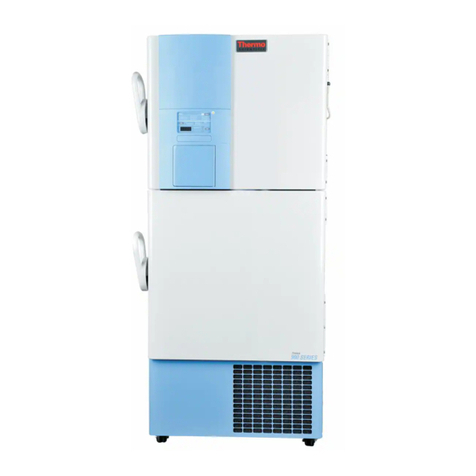
Thermo Forma
Thermo Forma 900 Series Operating instructions

Thermo Forma
Thermo Forma 8097 Operating instructions
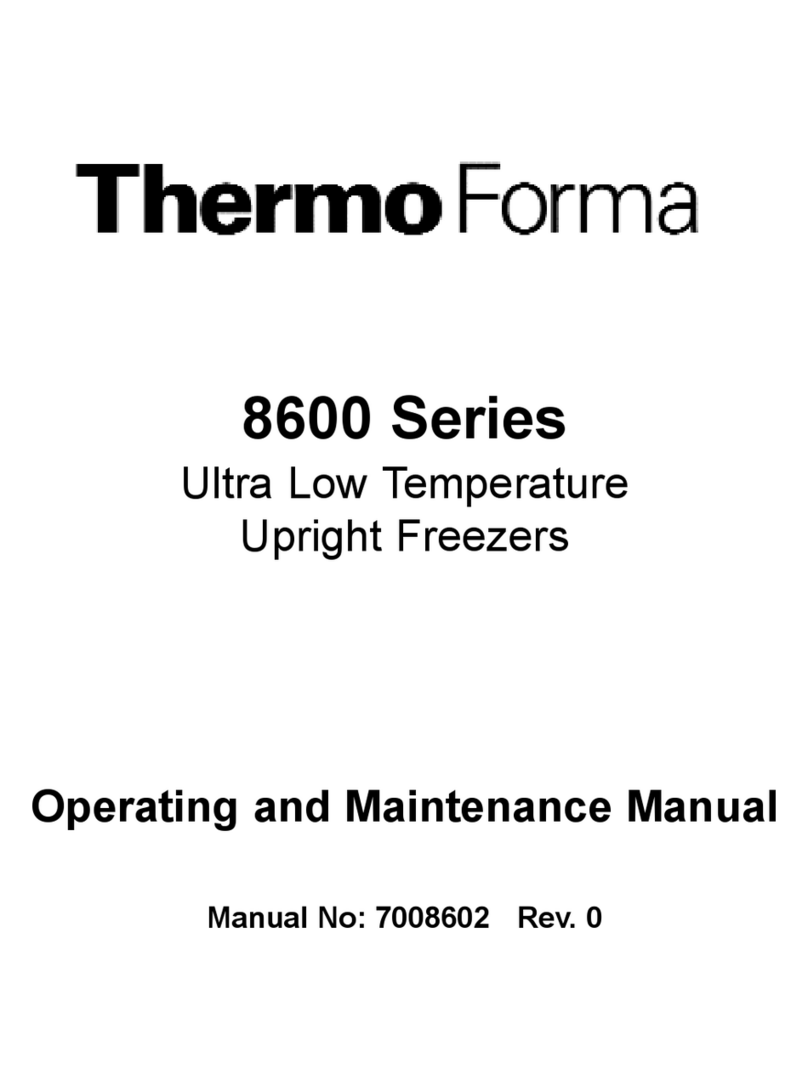
Thermo Forma
Thermo Forma 8600 Series Operating instructions

Thermo Forma
Thermo Forma 3795 Operating instructions

Thermo Forma
Thermo Forma Power Plus 8500 Series Operating instructions
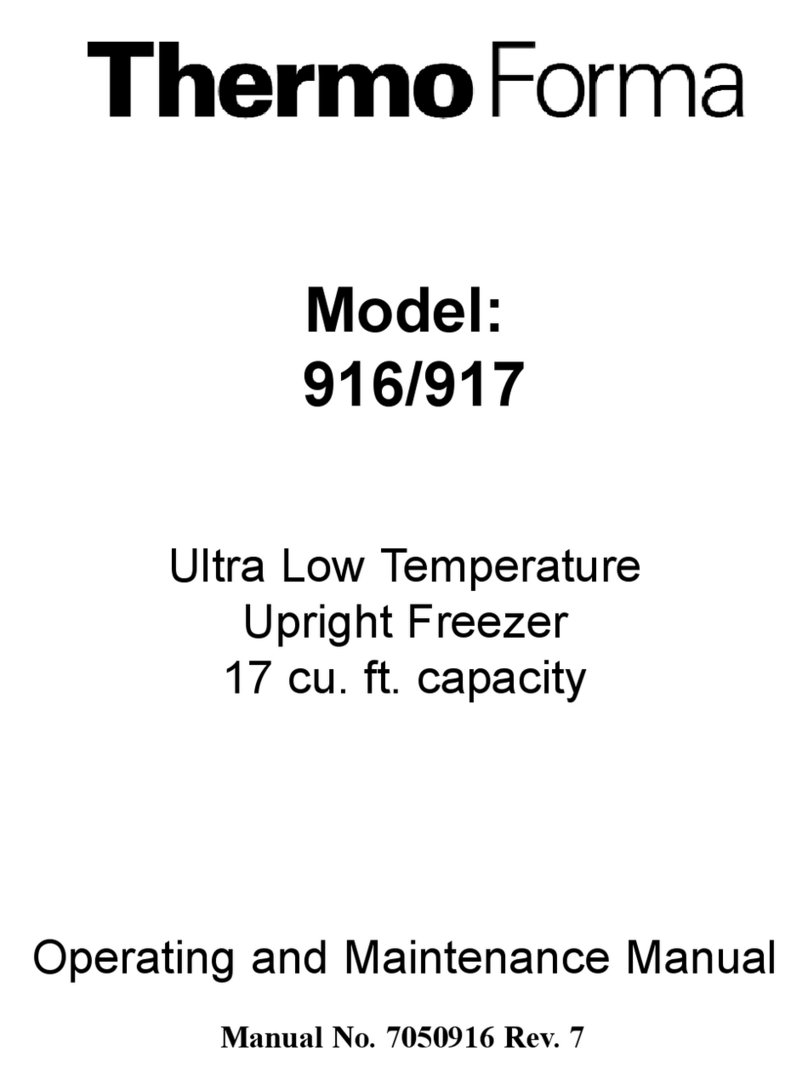
Thermo Forma
Thermo Forma 916 Operating instructions


